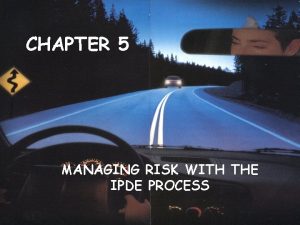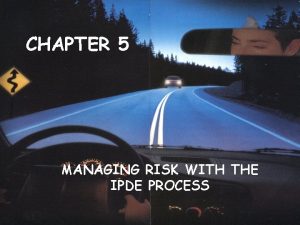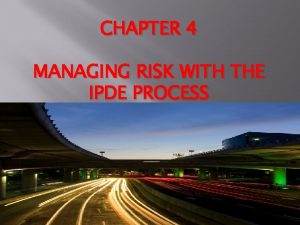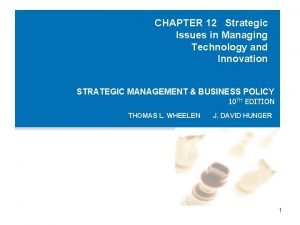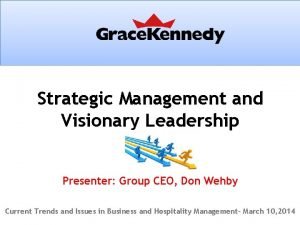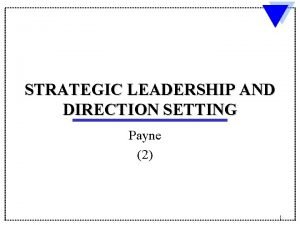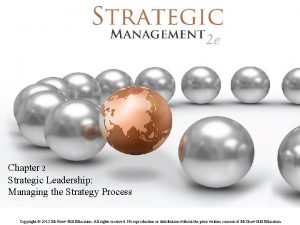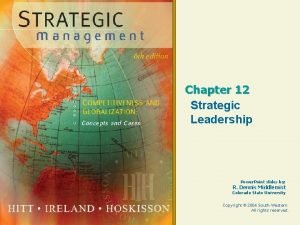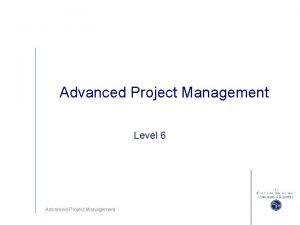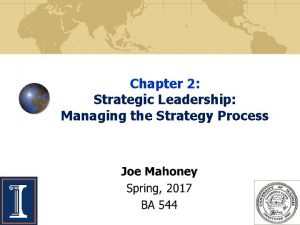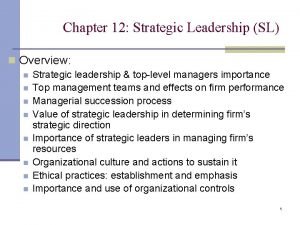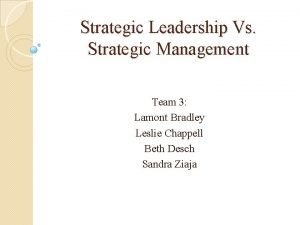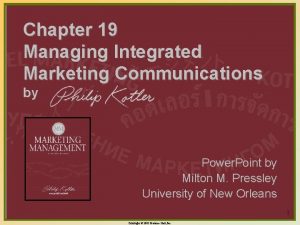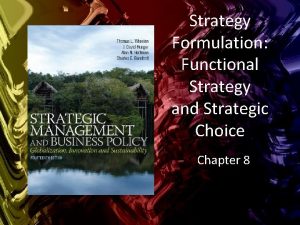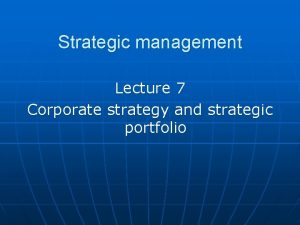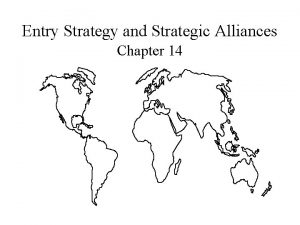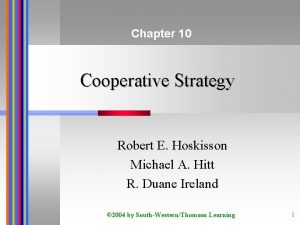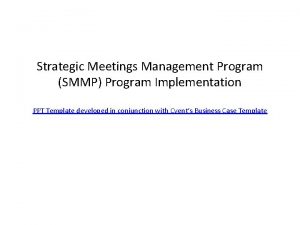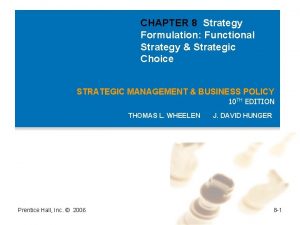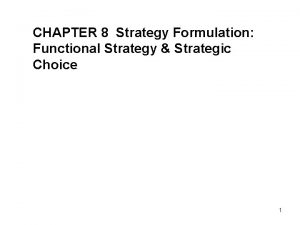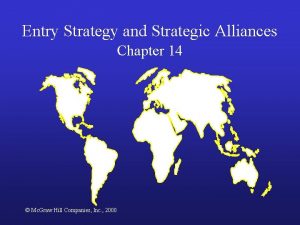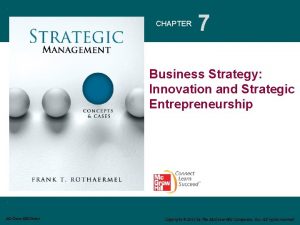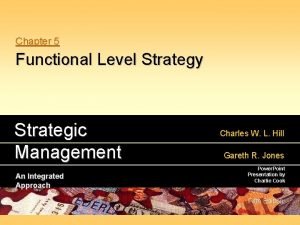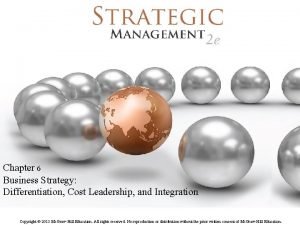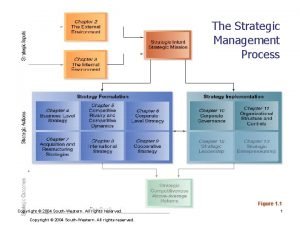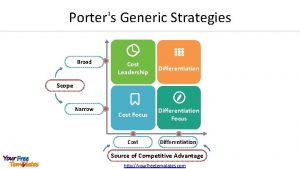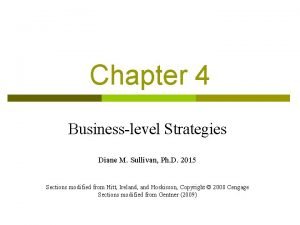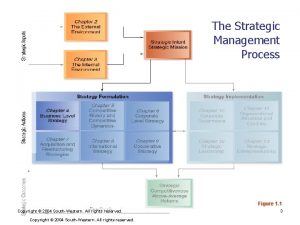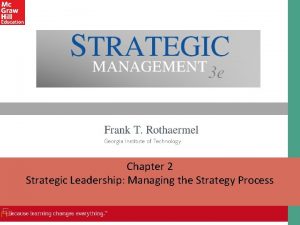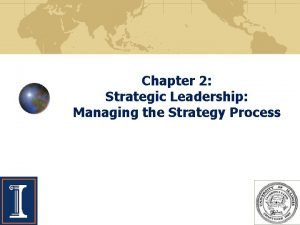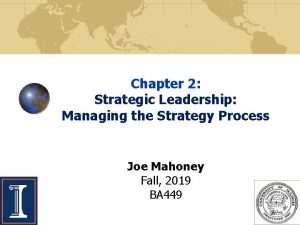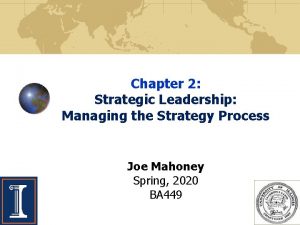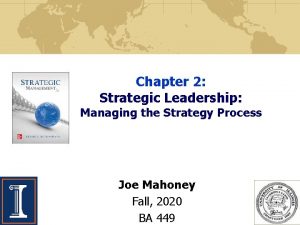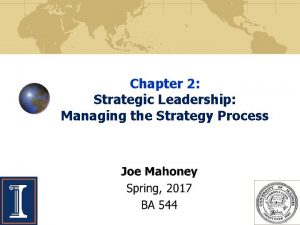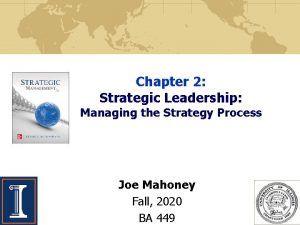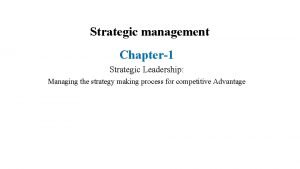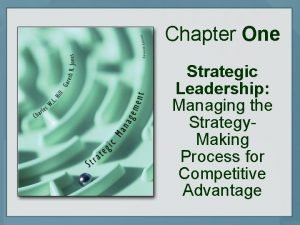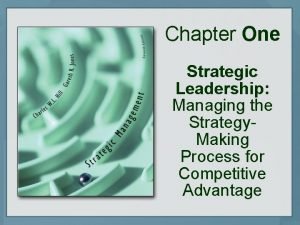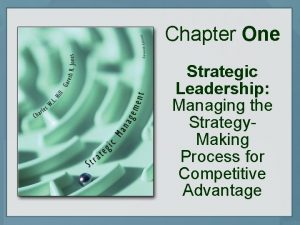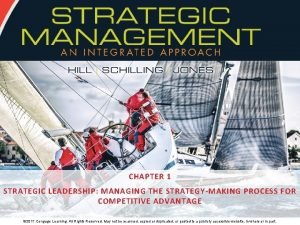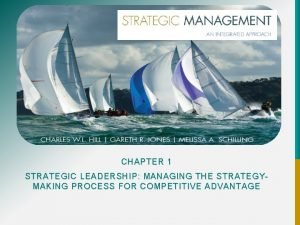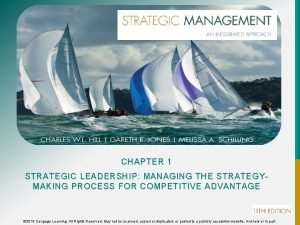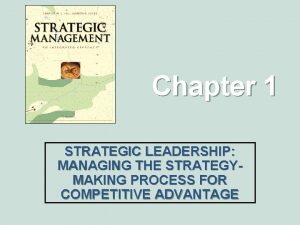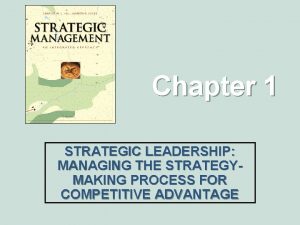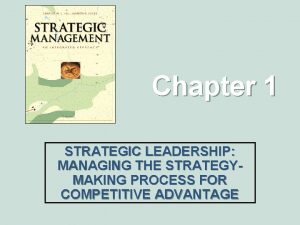Chapter 2 Strategic Leadership Managing the Strategy Process














































- Slides: 46

Chapter 2 Strategic Leadership: Managing the Strategy Process Copyright © 2015 Mc. Graw-Hill Education. All rights reserved. No reproduction or distribution without the prior written consent of Mc. Graw-Hill Education.

2 -2

Chapter Outline 2. 1 Vision, Mission, and Values • Vision and Mission • Living the Values 2. 2 Strategic Leadership • How Do You Become an Effective and Ethical Strategic Leader? • Formulating Strategy Across Levels: Corporate, Business, and Functional Managers 2. 3 The Strategic Management Process • Top-Down Strategic Planning • Scenario Planning • Strategy as Planned Emergence: Top-Down and Bottom-up 2. 4 Implications for the Strategist 2 -3

Chapter. Case 2 © Neville Elder/Corbis Pepsi. Co’s Indra Nooyi: “Performance with a Purpose” § $70 billion in annual revenues § 300, 000 worldwide employees § CEO Indra Nooyi had a leadership role in: • 1997 – Divestiture of Taco Bell, Pizza Hut, & KFC • 1998 – Acquisition of Tropicana • 2001 – Acquisition of Quaker Oats (including Gatorade) 2 -4

Chapter. Case 2 § Ms. Nooyi declared Pepsi. Co’s vision to be “Performance with a Purpose, ” defined by three dimensions: • Human sustainability • Environmental sustainability • The whole person at work § This triple-bottom-line competitive advantage approach considers economic, social, and environmental performance, underscoring CSR and stakeholder strategy. 2 -5

2. 1 Vision, Mission, and Values Strategic management process Process employed by strategic leaders to conceive and implement a strategy, which leads to sustainable competitive advantage Strategic leadership Executives’ use of power and influence to direct assets in the pursuit of an organization’s goals 2 -6

Vision and Mission VISION • Aspiration of the firm that lays the foundation for its mission – “to” is a common word MISSION • What an organization does, including products, services, and which markets – “by” is a common word 2 -7

FOR-PROFIT VS. NOT-FOR-PROFIT VISIONS § Main difference is the metric by which the firm assesses successful performance § TFA – success measured by the impact its teachers have on student performance § For-Profit firms – success measured by financial performance § Competitive Advantage – vision is aspirational, not exclusively financial 2 -8

Exhibit 2. 1 Teach For America 2 -9

CUSTOMER-ORIENTED VS. PRODUCT-ORIENTED § Customer-oriented vision statements allow firms to adapt to changing environments. § Product-oriented vision statements are less flexible. § Strategic flexibility is a necessary condition to achieve competitive advantage. 2 -10

PRODUCT-ORIENTED VISION STATEMENTS § A product-oriented vision defines a business in terms of a good or service. § Product-oriented visions tend to force managers to take a myopic view of the business landscape. 2 -11

CUSTOMER-ORIENTED VISION STATEMENTS § A customer-oriented vision defines a business in terms of providing solutions to customer needs and are more flexible. § Example: We are in the business of providing solutions to professional communication needs. § However the company needs to be careful to differentiate between a customer-oriented vision and following customer sentiments. 2 -12

Exhibit 2. 2 Companies with Customer. Oriented Vision Statements 2 -13

EVOLUTION OF INTEL CORPORATION VISION STATEMENT § Early – to be the preeminent building-block supplier of the PC industry § 1999 – to be the preeminent building-block supplier to the Internet economy § 2008 – to delight our customers, employees, and shareholders by relentlessly delivering the platform and technology advancements that become essential to the way we work and live 2 -14

Living the Values are ethical standards/norms that govern the behavior of individuals within a firm. Two Important Functions: 1. Values form a foundation for a firm’s vision and mission. 2. Values serve as the guardrails to keep the company on track. 2 -15

Strategy Highlight 2. 1 § § Merck: Reconfirming Its Core Values Founder George W. Merck’s words form the basis of the company’s values even today. Merck ended River Blindness in Africa, Latin America & the Middle East by donating its recently discovered drug Mectizan. However, these values were challenged with the Vioxx Case. The firm did voluntarily pull the drug off the market when evidence linking heart attacks and strokes to Vioxx was revealed, Resulting in Merck shares falling 27%. 2 -16

2. 2 Strategic Leadership ORGANIZATIONAL COMMITMENT § Strategic leadership – the behaviors and styles of executives that influence others to achieve the organization’s vision and mission § Strategic leaders impact firm performance as do leaders whose decisions lead to huge destruction of shareholder wealth and jobs. 2 -17

Exhibit 2. 3 How CEOs Spend Their Days SOURCE: Author’s depiction of data from O. Bandiera, A. Prat, and R. Sadun (2012), “Managerial capital at the top: Evidence from the time use of CEOs, ” London School of Economics and Harvard Business School Working Paper. 2 -18

How Do You Become an Effective and Ethical Strategic Leader? § Upper-echelons theory – Framework that views organizational outcomes – strategic choices and performance levels – as reflections of top management values, who interpret situations through their unique perspective lens § Strong leadership is the result of both innate abilities and learning. 2 -19

GOOD TO GREAT § Jim Collins identified great companies as those that transitioned from average performance to sustained competitive advantage. § He measured that transition as “cumulative stock returns of 6. 9 times the general market in the 15 years following their transition points. ” 2 -20

Exhibit 2. 4 Strategic Leaders: The Level 5 Pyramid 2 -21

Formulating Strategy Across Levels: Corporate, Business, and Functional Managers CORPORATE STRATEGY • Where to compete (industry, markets, and geography) BUSINESS STRATEGY • How to compete (cost leadership, differentiation, or integration) FUNCTIONAL STRATEGY • How to implement a business strategy 2 -22

Exhibit 2. 5 Strategy Formulation & Implementation Across Levels: Corporate, Business, and Functional Strategy 2 -23

2. 3 The Strategic Management Process When strategizing for competitive advantage, managers rely on three different approaches. This order represents how these approaches were developed over time. STRATEGIC PLANNING SCENARIO PLANNING STRATEGY AS PLANNED EMERGENCE 2 -24

Top-Down Strategic Planning § Top-down strategic planning – Rational, top-down process aiding in programming for future success § Information flows only one way: top-down. § Centralized strategic intelligence and decision-making § Exhibit 2. 6 illustrates the three steps of analysis, formulation, and implementation in a traditional topdown strategic planning process. 2 -25

Exhibit 2. 6 Top-Down Strategic Planning in the AFI Framework 2 -26

Scenario Planning Managers envision different what-if scenarios to anticipate plausible futures. § Scenario planning takes place at both the corporate and business levels of strategy. § Addresses both optimistic and pessimistic futures § Exhibit 2. 7 illustrates the use of scenario planning with the AFI strategy framework. 2 -27

Exhibit 2. 7 Scenario Planning Within the AFI Strategy Network 2 -28

SCENARIO PLANNING: ANALYSIS Analysis stage • Managers brainstorm to identify possible future scenarios, with critical inputs from different hierarchies and different functional areas (e. g. , R&D, manufacturing, and marketing & sales). Examples of external forces to be considered: • • Exchange rate fluctuations Currency appreciation/depreciation Financial crises impacting credit/equity/liquidity Black Swan events (impactful & unpredictable) 2 -29

SCENARIO PLANNING: FORMULATION Formulation stage • Management teams develop different strategic plans to address possible future scenarios. § These capture the firm’s internal and external environments and answer key questions. § From the portfolio of options, managers transform the most viable options into full-fledged, detailed strategic plans that can be activated and executed as needed. 2 -30

SCENARIO PLANNING: IMPLEMENTATION Implementation stage • Executives decide which option most closely matches the current reality and managers implement the dominant strategic plan. § The iterative, interdependent relationship among analysis, formulation, and implementation enhances organizational learning and strategic flexibility. 2 -31

Strategy as Planned Emergence: Top-Down and Bottom-Up § Critics of top-down and scenario planning argue that strategic planning is not the same as strategic thinking. § Most notable of these critics, Henry Mintzberg, proposed a third approach to the strategic management process. § From this viewpoint, managers must synthesize all available input from different internal/external sources into an overall strategic vision. 2 -32

Exhibit 2. 8: Realized Strategy Combines Top-Down and Bottom-Up 2 -33

Strategic initiative • Activity a firm pursues to explore and develop new products and processes, new markets, or new ventures Strategic initiatives may develop through: • Autonomous actions by lower-level employee • Serendipity (random events, pleasant surprises, accidental happenstances) • The Resource Allocation Process (RAP) 2 -34

Strategy Highlight 2. 2 Starbucks’s CEO: “It’s Not What We Do” § The story of Frappuccino® is chronicled in this Strategy Highlight, including: • The strong resistance by top executives • The tenacious determination of one store manager, Diana • The importance of a product champion for autonomous innovation • The culmination of Frappuccino being a billion-dollar business for Starbucks 2 -35

STRATEGIC INITIATIVES VIA AUTONOMOUS ACTIONS § Google employs a 70 -20 -10 rule when organizing the work of its engineers: • 70% is focused on its main business (search and ads) • 20% is spent on ideas of their own choosing • 10% is devoted to total wild cards (e. g. , driverless car) § Google reports that half of its new products came from the 20 percent rule. 2 -36

STRATEGIC INITIATIVES VIA AUTONOMOUS ACTIONS § Championed by a mid-level engineer, GE’s leadership relented and bought Enron Wind for $200 million. § A huge success, generating revenues over $10 billion in 2012, this acquisition opened up significant alternativeenergy opportunities, including GE’s ecomagination. § From product-oriented to consumer-oriented, from Welch to Immelt, GE transitions are underscored. 2 -37

2. 4 Implications for the Strategist THREE STRATEGIC PROCESSES § The three strategy processes discussed in this chapter, each have strengths and weaknesses. Important variables to consider: • Rate of environmental change (internal/external) • Firm size • Employee commitment to vision, mission, and organizational values 2 -38

Chapter. Case 2 © Neville Elder/Corbis Consider This… § The stakeholder strategy approach adopted by Indra Nooyi is applauded by some, yet performance under Pepsi. Co’s “Performance with a Purpose” vision is lagging behind Coke and Diet Coke. § Should Ms. Nooyi be replaced? § Should Pepsi. Co be split into a beverage and snack foods company in order to leverage unbundled profit potential? 2 -39

Take-Away Concepts § A vision captures an organization’s LO 2 -1 aspirations. An effective vision inspires Describe the roles and motivates members of the of vision, mission, organization. and values in the § A mission statement describes what an strategic organization actually does—what its management business is—and why and how it does process. it. § Values define the ethical standards and norms that should govern the behavior of individuals within the firm. 2 -40

Take-Away Concepts LO 2 -2 Evaluate the strategic implications of product-oriented and customeroriented vision statements. § Product-oriented vision statements define a business in terms of a good or service provided. § Customer-oriented vision statements define business in terms of providing solutions to customer needs. § Customer-oriented vision statements provide managers with more strategic flexibility than product-oriented missions. § To be effective, visions and missions need to be backed up by hard-to-reverse strategic commitments. 2 -41

Take-Away Concepts § Employees tend to follow values practiced LO 2 -3 by strategic leaders. Without commitment Explain why from top managers, statements of values anchoring a firm in remain merely public relations exercises. ethical values is essential for long- § Ethical values are the guardrails that help term success. keep the company on track when pursuing its mission and its quest for competitive advantage. 2 -42

Take-Away Concepts LO 2 -4 Outline how managers become strategic leaders. § To become an effective strategic leader, a manager needs to develop skills to move sequentially through five different leadership levels: highly capable individual, contributing team member, competent manager, effective leader, and executive. 2 -43

Take-Away Concepts LO 2 -5 Describe the roles of corporate, business, and functional managers in strategy formulation and implementation. § Corporate executives must provide answers to the question of where to compete (in industries, markets, and geographies), and how to create synergies among different business units. § General managers in strategic business units must answer the strategic question of how to compete in order to achieve superior performance. They must manage and align the firm’s different functional areas for competitive advantage. § Functional managers are responsible for implementing business strategy within a single functional area. 2 -44

Take-Away Concepts LO 2 -6 Evaluate top-down strategic planning, scenario planning, and strategy as planned emergence. § Top-down strategic planning is a sequential, linear process that works reasonably well when the environment does not change much. § In scenario planning, managers envision what-if scenarios and prepare contingency plans that can be called upon when necessary. § Strategic initiatives can be the result of top-down planning or can emerge through a bottom-up process from deep within the organization. They have the potential to shape a firm’s strategy. § A firm’s realized strategy is generally a combination of its top-down intended strategy and bottom-up emergent strategy, resulting in planned emergence. 2 -45

2 -46
 The strategy making strategy executing process
The strategy making strategy executing process Managing risk with the ipde process
Managing risk with the ipde process Ipde process examples
Ipde process examples Ipde process definition
Ipde process definition Managing risk with the ipde process
Managing risk with the ipde process Chapter 4 managing risk with the ipde process
Chapter 4 managing risk with the ipde process Strategic issues in managing technology and innovation
Strategic issues in managing technology and innovation Strategic fit vs strategic intent
Strategic fit vs strategic intent Strategic substitutes and strategic complements
Strategic substitutes and strategic complements Io model strategic management
Io model strategic management Strategy analysis and choice largely involves making
Strategy analysis and choice largely involves making Visionary leadership and strategic management
Visionary leadership and strategic management Strategic leadership
Strategic leadership Customer-oriented visions do not
Customer-oriented visions do not Key strategic leadership actions
Key strategic leadership actions Advanced project management and strategic leadership
Advanced project management and strategic leadership Level 5 pyramid of strategic leadership
Level 5 pyramid of strategic leadership Key strategic leadership actions
Key strategic leadership actions Cost leadership in strategic management
Cost leadership in strategic management Leadership vs management
Leadership vs management Strategic leadership roles
Strategic leadership roles Leadership fe
Leadership fe Transactional leadership vs transformational leadership
Transactional leadership vs transformational leadership Adaptive leadership style
Adaptive leadership style Situational leadership vs adaptive leadership
Situational leadership vs adaptive leadership Communications mix
Communications mix What is functional strategy
What is functional strategy What is corporate strategy in strategic management
What is corporate strategy in strategic management Strategic management chapter 7
Strategic management chapter 7 Entry strategy and strategic alliances
Entry strategy and strategic alliances Cooperative strategy in strategic management
Cooperative strategy in strategic management Strategic meetings management strategy
Strategic meetings management strategy Functional strategy and strategic choice
Functional strategy and strategic choice Subjective factors in strategic choice
Subjective factors in strategic choice Market entry modes for international businesses chapter 7
Market entry modes for international businesses chapter 7 Making strategy: mapping out strategic success
Making strategy: mapping out strategic success Strategy
Strategy Formulation of functional strategy
Formulation of functional strategy Hypercompetition
Hypercompetition Business-level strategy
Business-level strategy Differentiation cost leadership
Differentiation cost leadership Cost leadership strategy
Cost leadership strategy Walmart cost leadership
Walmart cost leadership Multidivisional structure disadvantages
Multidivisional structure disadvantages Broad cost leadership strategy
Broad cost leadership strategy Diane m sullivan
Diane m sullivan Cost leadership strategy
Cost leadership strategy

